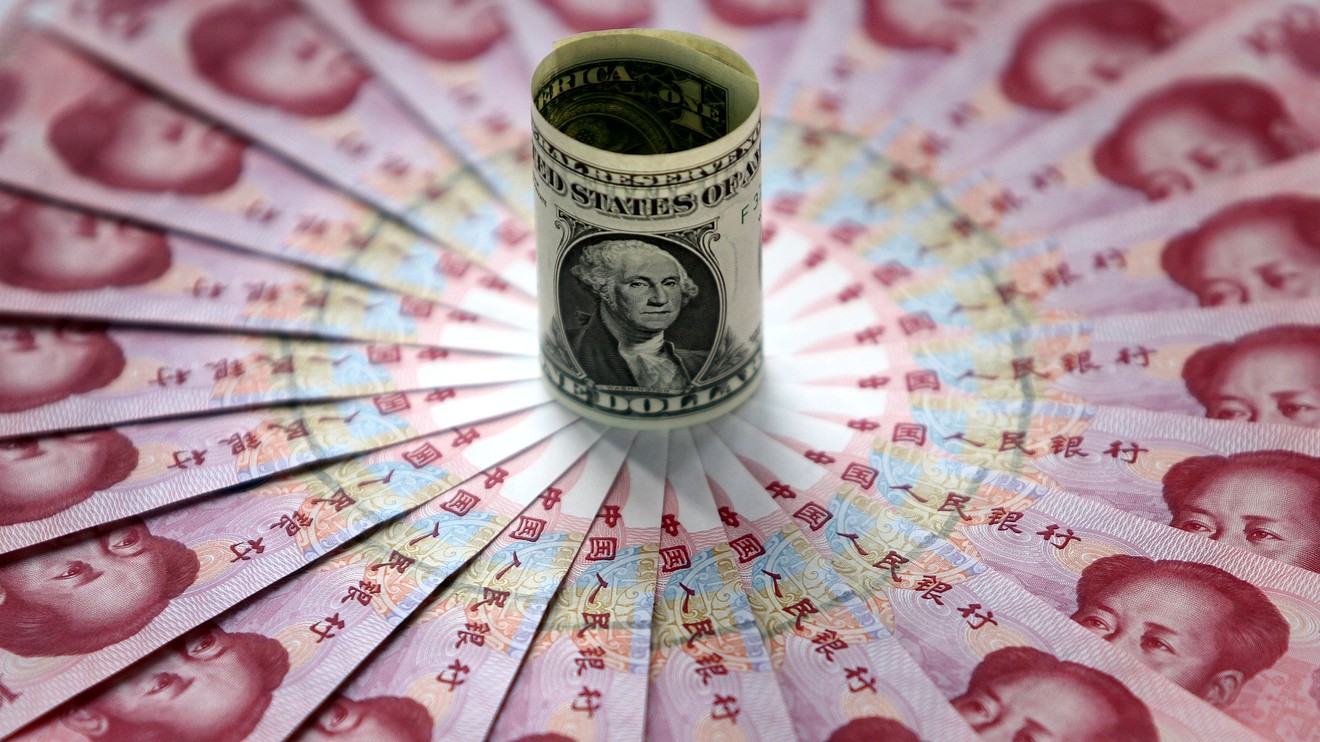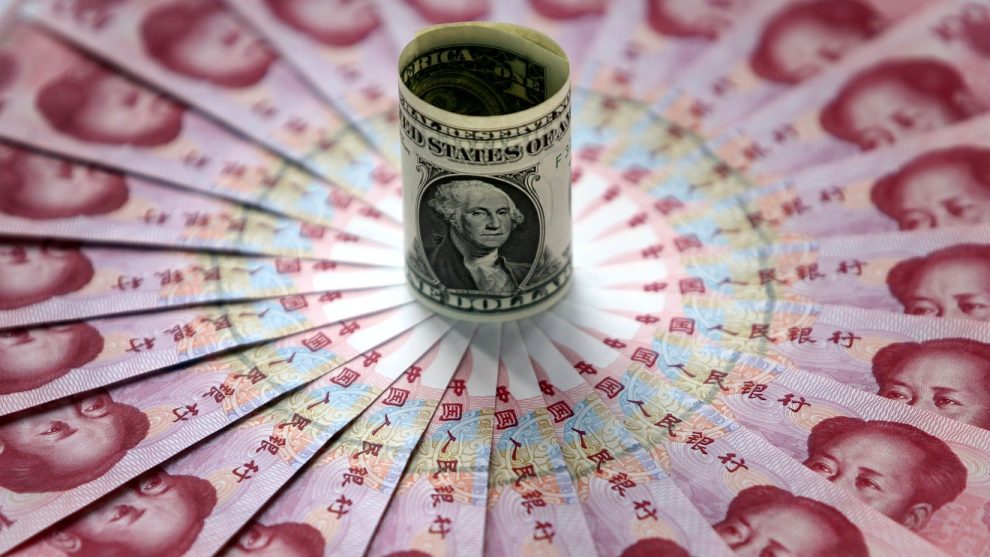
China’s yuan currency tumbled Monday, breaching a level long described by market watchers as a “line in the sand” and feeding fears of an intensifying China-U.S. trade war. In turn, that sparked a global equity-market selloff that saw U.S. stocks suffer their biggest one-day decline of 2019.
Why are investors rattled, and how concerned should they really be? Here’s what you need to know:
What happened?
China’s currency weakened early Monday, trading at more than 7 yuan per U.S. dollar for the first time in more than a decade. In offshore trading, the yuan USDCNH, -0.0014% sank to a record low of more than 7.10 yuan per dollar, according to The Wall Street Journal. In recent offshore action, the yuan traded at 7.0949 per dollar, after having changing hands at 7.0507 in onshore trading USDCNY, +0.0000% .
The move came after the People’s Bank of China set its daily reference rate at more than 6.9 yuan per dollar for the first time since December. In onshore trading, the yuan is allowed to trade in a band that can fluctuate 2% on either side of the reference rate.
Why did stocks sell off?
While economists and traders debated whether the yuan weakness signaled a willingness by Beijing to use the yuan as a weapon in the trade war, investors fled stocks and other assets perceived as risky as the outlook for a deal between the U.S. and China suffered a heavy blow.
See: China-sensitive stocks slide sharply as yuan move adds to trade-war fears
Wall Street joined in a global selloff, with stocks extending sharp losses in afternoon trade. The Dow Jones Industrial Average DJIA, -0.34% fell more than 900 points at its session low before ending the day down 767.27 points, or 2.9%, while the S&P 500 SPX, -0.66% suffered a 3% fall. The tech-heavy Nasdaq Composite COMP, -1.00% slumped 3.5% as China-sensitive stocks took a hit.
Read: Global recession will come in 9 months if Trump takes this one step, Morgan Stanley argues
There had been a “curious tendency” in the markets to think that both China and the U.S. wanted and needed a deal and that the desire to put one in place would soon lead to an agreement, said Paul Christopher, head of global market strategy for Wells Fargo Investment Institute.
“We think China’s moves today signal that they are prepared to use a variety of measures and push these negotiations well into 2020,” Christopher said, in a phone interview. “There’s not going to be an easy deal here for the U.S.”
The weakening yuan, meanwhile, also stirred memories of a messy 2015 devaluation of the currency that sent shock waves through global financial markets over several months, he said.
What does it have to do with the trade war?
With the 7-yuan level long described by economists and market participants as a “line in the sand” or a “magic number,” the decline on Monday was taken by investors as a response to President Donald Trump’s surprise decision last week to impose 10% tariffs on $300 billion worth of imports from China not already subject to levies, effective Sept. 1.
Chinese officials didn’t try too hard to dissuade that interpretation, with the People’s Bank of China saying in a statement that the currency’s decline was “due to the effects of unilateralist and trade-protectionist measures and the expectations for tariffs against China.”
The move angered Trump, who accused China of “currency manipulation” in a series of tweets.
Is China using the yuan as a weapon?
While Monday’s move appeared designed to send a message, currency-watchers were divided about whether China was poised to use the yuan as a weapon in the trade battle.
Allan von Mehren, chief analyst at Danske Bank, noted that while the 7-yuan-per-dollar level has long been seen as an important level by traders and economists, PBOC Governor Yi Gang has emphasized that “no specific yuan level” was important.
“This looks more like a warning shot than active devaluation, with the yuan’s fall a reflection of worsening economic fundamentals and rising trade tariff risks,” Mark Haefele, chief investment officer for global wealth management at UBS, wrote in a note. “For policy makers in China, arbitrarily defending the 7.0 mark amid these pressures represents a moral hazard, and one which only worsens the longer it is left to build up.”
While the yuan is likely to weaken further in response to economic headwinds, China will want to avoid an outright devaluation that von Mehren and other analysts warned could quickly backfire.
Chinese officials, they said, will be eager to avoid a repeat of th 2015-’16 episode, which saw significant capital outflows. Also, China’s policy makers know that excessive and sudden depreciation would put heavy pressure on other Asian currencies, quickly neutralizing any trade benefits for Chinese exporters, who would lose out to rivals in Taiwan and South Korea, wrote analysts at Macquarie, in a Monday note.
A much weaker yuan would also inflict pain on Chinese importers, consumers and, especially, businesses that have borrowed in U.S. dollars, they said.
But Alan Ruskin, chief international strategist at Deutsche Bank, said that while there is a strong argument for the PBOC to signal that 7 was merely a number and that it was ready to tolerate some foreign-exchange flexibility, China “did not have to let the currency weaken sharply so close to the Trump tariff announcement, in a way that leaves an impression that the currency is being used as a retaliatory tool for U.S. actions on trade.”
Ruskin, in a note, said it should be obvious that “the FX ‘tool’ is a double-edged sword, potentially hurting both the U.S. and China.”
He also said there may be “some realization” that the U.S. could add to tariffs if the currency is used to offset the impact of the levies — a policy that would be more effective than direct U.S. currency intervention. White House economic advisor Larry Kudlow last month said that intervention to weaken the U.S. had been ruled out, though the continued U.S.-China tensions has led analysts not to rule out the prospect.
See: Currency intervention: Here’s how the U.S. could move to weaken the dollar
What’s next?
Obviously, investors will be paying close attention to the yuan, particularly the next fixing.
The S&P 500’s 200-day moving average near 2,800 is likely to prove an important test of support for stocks, Wells Fargo’s Christopher said.
“Whether we go [below] that really depends on what happens in the September negotiations,” he said. While no deal is likely until 2020, there will likely be periods when talks appear to be making progress and as well as setbacks, he said, with volatility likely to provide investors chances to trim positions when the S&P 500 comes near the firm’s 3,030 target and take advantage of buying opportunities on pullbacks.









